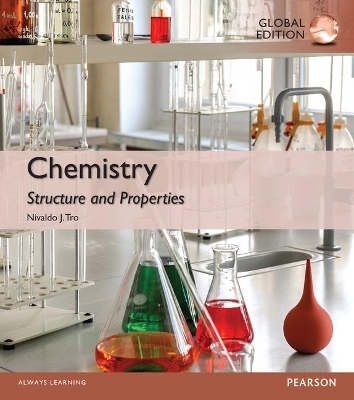
Chemistry: Structure and Properties with MasteringChemistry, Global Edition
Pearson Education Limited
978-1-292-07080-3 (ISBN)
- Titel ist leider vergriffen;
keine Neuauflage - Artikel merken
His consistent conceptual focus and step-by-step problem-solving framework encourages students to think through processes rather than simply memorize content. Interactive media within MasteringChemistry(R) complements the book's problem-solving approach, thus creating a comprehensive program that enables students to learn both in and out of the classroom. This program presents a better teaching and learning experience-for you and your students. *Developed with a central theme and by a teaching community: As part of a community that teaches with the understanding that matter is composed of particles and the structure of those particles determines the properties of matter, Dr. Tro took great lengths in the text to ensure that everything from organization, art, and pedagogy reinforce this theme. The result of this emphasis is that the topic order has been constructed to make key connections earlier, stronger, and more often than the traditional approach.
*Linking conceptual understanding with problem-solving skills: Throughout each chapter, numerous Conceptual Connections encourage comprehension of the most complex concepts while a consistent step-by-step framework in the worked examples allows students to think logically through the problem-solving process. *Visualizing and understanding chemistry: Revolutionary multipart images illustrate and reinforce the theme of the text and allow students to see and experience the molecules responsible for the structures and properties of matter. *Personalized learning with MasteringChemistry: This online homework, tutorial, and assessment program is designed to improve results by helping students quickly master concepts. Students benefit from self-paced tutorials, featuring specific wrong-answer feedback and hints that emulate the office-hour experience. This package includes MasteringChemistry, an online homework, tutorial, and assessment program designed to work with this text to personalize learning and improve results. With a wide range of interactive, engaging, and assignable activities, students are encouraged to actively learn and retain tough course concepts.
My_Lab/Mastering is not a self-paced technology and should only be purchased when required by an instructor. Please be sure you have the correct ISBN and Course ID. Instructors, contact your Pearson representative for more information.
1 Atoms
1.1 A Particulate View of the World: Structure Determines Properties
1.2 Classifying Matter: A Particulate View
1.3 The Scientific Approach to Knowledge
1.4 Early Ideas about the Building Blocks of Matter
1.5 Modern Atomic Theory and the Laws That Led to It
1.6 The Discovery of the Electron
1.7 The Structure of the Atom
1.8 Subatomic Particles: Protons, Neutrons, and Electrons
1.9 Atomic Mass: The Average Mass of an Element’s Atoms
1.10 The Origins of Atoms and Elements
2 Measurement, Problem Solving, and the Mole Concept
2.1 The Metric Mix-up: A $125 Million Unit Error
2.2 The Reliability of a Measurement
2.3 Density
2.4 Energy and Its Units
2.5 Converting between Units
2.6 Problem-Solving Strategies
2.7 Solving Problems Involving Equations
2.8 Atoms and the Mole: How Many Particles?
3 The Quantum-Mechanical Model of the Atom
3.1 Schrödinger’s Cat
3.2 The Nature of Light
3.3 Atomic Spectroscopy and the Bohr Model
3.4 The Wave Nature of Matter: The de Broglie Wavelength, the Uncertainty Principle, and Indeterminacy
3.5 Quantum Mechanics and the Atom
3.6 The Shapes of Atomic Orbitals
4 Periodic Properties of the Elements
4.1 Aluminum: Low-Density Atoms Result in Low-Density Metal
4.2 Finding Patterns: The Periodic Law and the Periodic Table
4.3 Electron Configurations: How Electrons Occupy Orbitals
4.4 Electron Configurations, Valence Electrons, and the Periodic Table
4.5 How the Electron Configuration of an Element Relates to Its Properties
4.6 Periodic Trends in the Size of Atoms and Effective Nuclear Charge
4.7 Ions: Electron Configurations, Magnetic Properties, Ionic Radii, and Ionization Energy
4.8 Electron Affinities and Metallic Character
5 Molecules and Compounds
5.1 Hydrogen, Oxygen, and Water
5.2 Types of Chemical Bonds
5.3 Representing Compounds: Chemical Formulas and Molecular Models
5.4 The Lewis Model: Representing Valence Electrons with Dots
5.5 Ionic Bonding: The Lewis Model and Lattice Energies
5.6 Ionic Compounds: Formulas and Names
5.7 Covalent Bonding: Simple Lewis Structures
5.8 Molecular Compounds: Formulas and Names
5.9 Formula Mass and the Mole Concept for Compounds
5.10 Composition of Compounds
5.11 Determining a Chemical Formula from Experimental Data
5.12 Organic Compounds
6 Chemical Bonding I: Drawing Lewis Structures and Determining Molecular Shapes
6.1 Morphine: A Molecular Imposter
6.2 Electronegativity and Bond Polarity
6.3 Writing Lewis Structures for Molecular Compounds and Polyatomic Ions
6.4 Resonance and Formal Charge
6.5 Exceptions to the Octet Rule: Odd-Electron Species, Incomplete Octets, and Expanded Octets
6.6 Bond Energies and Bond Lengths
6.7 VSEPR Theory: The Five Basic Shapes
6.8 V
| Erscheint lt. Verlag | 25.2.2015 |
|---|---|
| Verlagsort | Harlow |
| Sprache | englisch |
| Maße | 246 x 267 mm |
| Gewicht | 2506 g |
| Themenwelt | Naturwissenschaften ► Chemie |
| ISBN-10 | 1-292-07080-3 / 1292070803 |
| ISBN-13 | 978-1-292-07080-3 / 9781292070803 |
| Zustand | Neuware |
| Haben Sie eine Frage zum Produkt? |
aus dem Bereich


